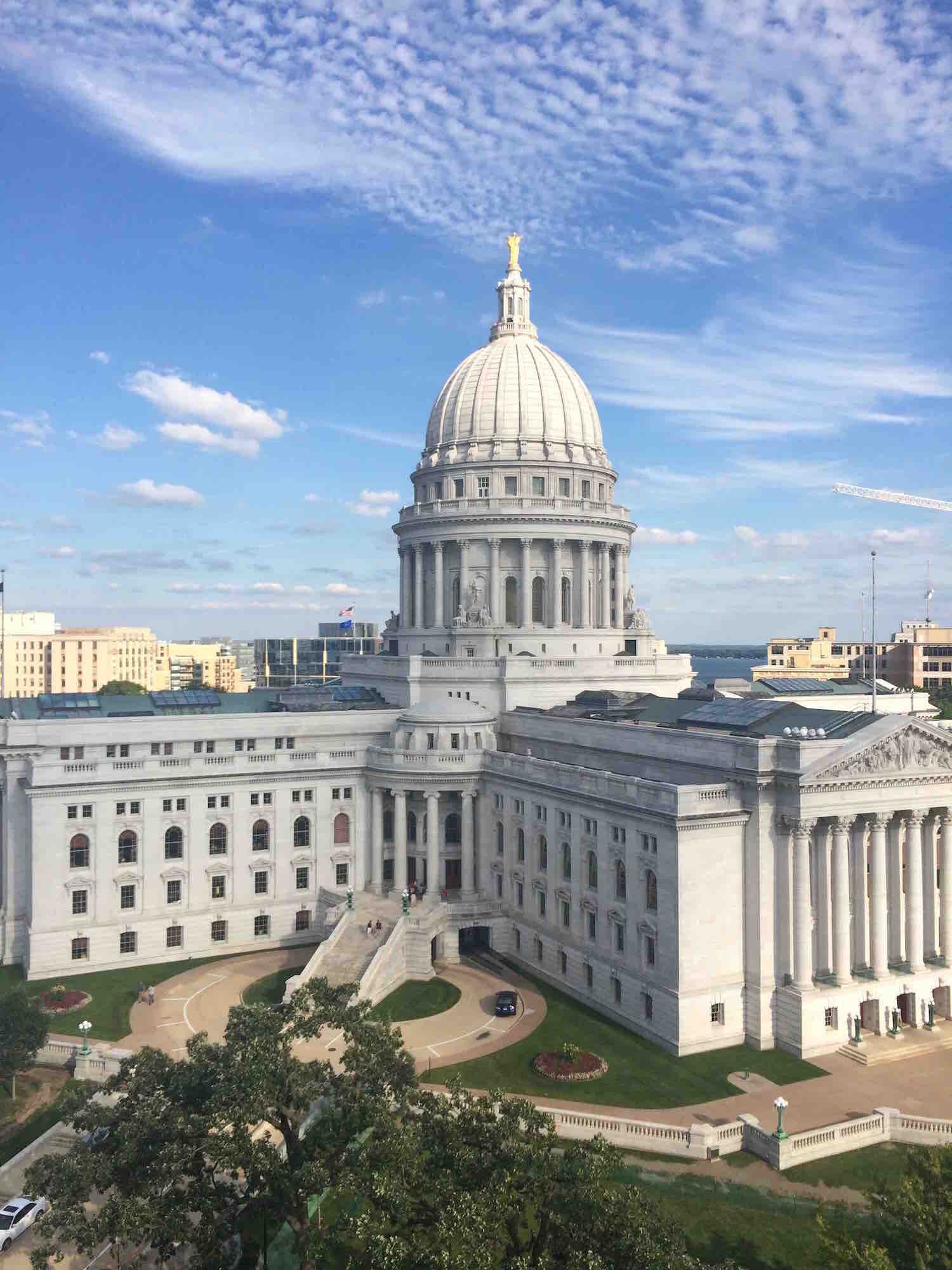National Historic Landmarks
By Michael Bridgeman
Dane County’s National Historic Landmarks
The Dairy Barn on the University of Wisconsin-Madison campus, the La Follette house in Maple Bluff, and the State Capitol in Madison share an important distinction. Each is a National Historic Landmark (NHL). To gain that status each property had to meet high standards before designation by the Secretary of the Interior.
In 1964 the Maple Bluff home of Robert and Belle La Follette (1860) became the first site in Dane County to be designated a National Historic Landmark. (Photo: WHS Architecture & History Inventory 5428)
The NHL program is distinct from the National Register of Historic Places. There are “two different programs, two different laws, two different methods,” as explained by Jim Gabbert, historian with the National Park Service (NPS), in a brief online video. The goals, standards, and nuts-and-bolts of the NHL program are detailed on an excellent website from the National Park Service, which administers the program.
Designated a National Historic Landmark in 2001, the Wisconsin State Capitol (1906-1917) has important associations with the Progressive Movement in the early twentieth century. (Photo: wikimedia commons)
Recognition as an NHL does not restrict what an owner may do with their property unless federal or state funding or permits are involved, such as building a highway. (The same is true of properties on the National Register of Historic Places.) Since NHLs are automatically added to the National Register they may also be eligible for tax credits under certain conditions.
Beyond red tape and guidelines, recognition as an NHL is unquestionably important and meaningful. Here’s a description from the NPS:
“National Historic Landmarks (NHLs) are cultural properties designated by the Secretary of the Interior as being nationally significant. Acknowledged as among the nation’s most significant historic places, these buildings, sites, districts, structures, and objects possess exceptional value or quality in illustrating or interpreting the heritage of the United States in history, architecture, archeology, engineering, and culture.”
The emphasis on exceptional value is critical according to Daina Penkiunas, State Historic Preservation Officer at the Wisconsin Historical Society. “Designation as a National Historic Landmark means clearing a very high bar,” she said. Penkiunas pointed out that there are 251 listed properties in Dane County on the National Register of which ten are National Historic Landmarks. “And that’s a high percentage,[1]” she added.
The Herbert and Katherine Jacobs First House (1937) in Madison is one of three local Frank Lloyd Wright buildings designated a National Historic Landmark. The others are the second Jacobs House and the First Unitarian Society Meeting House. (Photo: WHS Architecture & History Inventory 74000073)
This is the list of NHLs in Dane County and the year each was designated.
First Unitarian Society Meeting House — Shorewood Hills (2004)
Harold C. Bradley House — Madison (1976)
Herbert and Katherine Jacobs First House — Madison (2003)
Herbert and Katherine Jacobs Second House — Madison (2003)
North Hall (UW) — Madison (1965)
Robert M. La Follette Home — Maple Bluff (1964)
UW Armory and Gymnasium — Madison (1994)
UW Dairy Barn — Madison (2005)
UW Science Hall — Madison (1993)
Wisconsin Capitol — Madison(2001)
The UW Dairy Barn (1897) was designated a National Historic Landmark for work done here between 1907 and 1911 that had national impact on science, agriculture, health, and nutrition. (Photo: Jennifer Gurske, Madison Trust for Historic Preservation)
Of the ten Dane County NHLs, four are on the University of Wisconsin Madison campus and three others were designed by Frank Lloyd Wright. And there may soon be an 11th: the UW Arboretum. The nomination describes the “exceptional value or quality” that bolsters the Arboretum as an NHL:
“The research and experimentation carried out in the Arboretum beginning in the 1930s led to a better understanding of these [damaged] ecosystems and contributed importantly to the development of standardized conservation, restoration and management practices, and ultimately helped define the field of restoration ecology.””
The UW Arboretum (1927-1943) has been nominated as a National Historic Landmark for its nationally significant role in restoration ecology. If designated it will become the fifth NHL connected to the University of Wisconsin. (Photo: wikimedia commons)
And while the State Historic Preservation Office is not the conduit for NHL nominations, Penkiunas and her staff keep in eye on progress. “Getting a National Historical Landmark designation is time consuming and the Arboretum nomination has been working its way through the process,” she said. “The nomination was recently heard by the National Historic Landmarks Committee which gave its OK to move ahead.” Final designation will be decided by the Secretary of the Interior.
The Madison Trust for Historic Preservation features six NHLs on its historic architecture walking tours:
The Madison Trust’s historic architecture walking tour of University Heights includes the Harold and Josephine Bradley House (1908-1909). This National Historic Landmark was designed by Louis Sullivan. (Photo: Jennifer Gurske, Madison Trust for Historic Preservation)
Bascom Hill tour — North Hall, UW Armory and Gymnasium and UW Science Hall
University Heights tour — Harold and Josephine Bradley House
UW Agricultural Campus tour — UW Dairy Barn
Westmorland tour — Herbert and Katherine Jacobs First House
To see if these tours will be offered in 2021, check our tour pages in April when this summer’s schedule will be posted. And remember that you can schedule private tours, too.
- - -
[1] In Dane County 4.0 percent of National Register properties are NHLs. Nationally there are more than 90,000 properties on the National Register and about 2,500 NHLs or about 2.7 percent. There are 43 NHLs in Wisconsin.






